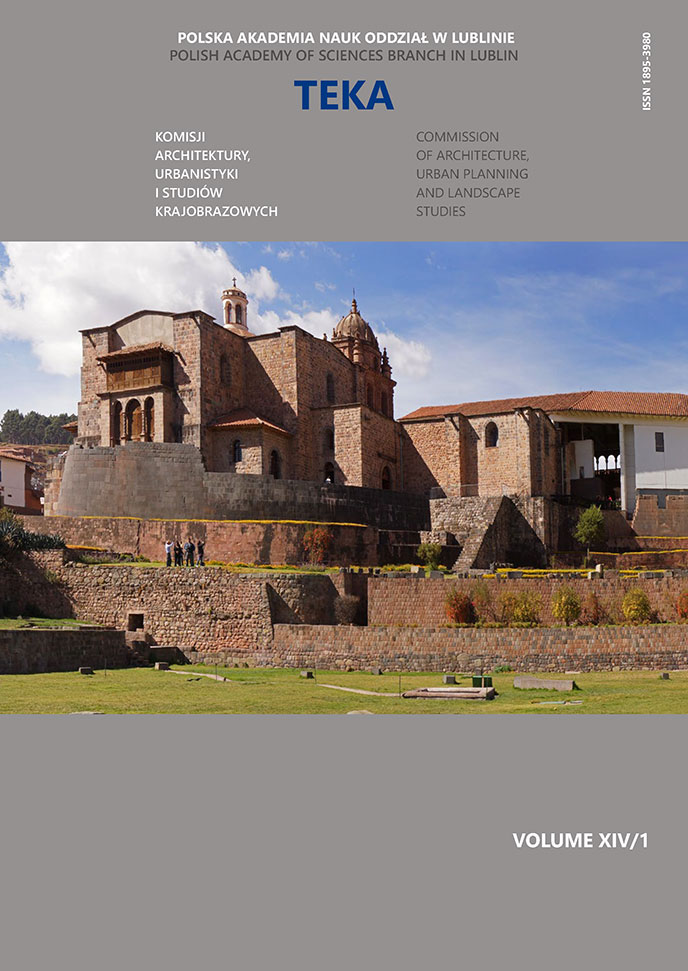Features of housing sanation in the historical architectural environment
Article Sidebar
Open full text
Issue Vol. 14 No. 1 (2018)
-
Astronomical observations in the Inca Temple of Coricancha (Cusco)? A critical review of the hypothesis
Mariusz Ziółkowski, Jacek Kościuk7-33
-
Lighting policy as an integral part of sustainable urban planning
Agata Łopuszyńska, Magdalena Belof34-43
-
Optical properties of opaque and light-transmitting photovoltaic systems in architecture and their influence on architectural form
Marcin Brzezicki, Magdalena Muszyńska-Łanowy44-54
-
Built environment of the tall housing buildings in Poland
Dariusz Gawel55-62
-
Features of housing sanation in the historical architectural environment
Kateryna Danko, Kashchenko Tetyana63-70
-
Hypothetic Reconstruction of The Development of The Defensive Structures of The Middle Town of Rohatyn in 15th−17th Centuries
Mykola Bevz71-88
-
The modernization of public spaces in problematic residential areas exemplified on selected projects and realizations in the Bronowice district of Lublin
Kamila Boguszewska, Natalia Przesmycka89-97
-
Project of revitalisation of the area next to the Potocki family Palace in Lublin
Patryk Krupiński, Krystyna Pudelska98-106
-
Classroom training strategies to strengthen the hotbed of research in architecture
Rolando Arturo Cubillos González107-115
-
Effect of accessibility in housing complexes on shaping of beauty in the urban environment. Selected examples from Cracow
Karolina Dudzic-Gyurkovich116-125
-
Architecture in transition: the case study of the dormition catedral in Volodymyr Volynskyi
Petro Rychkov126-135
-
The earliest public green areas connected with Jelenia Góra, part. 1.
Marzanna Jagiełło, Wojciech Brzezowski136-144
-
Overview and classification of housing forms intended for older and disable people occurring in high developed countries in context to deficit of similar forms in Poland
Monika Magdziak145-155
Archives
-
Vol. 16 No. 4
2020-12-30 11
-
Vol. 16 No. 3
2020-09-30 10
-
Vol. 16 No. 2
2020-06-30 11
-
Vol. 16 No. 1
2020-03-31 10
-
Vol. 15 No. 4
2019-12-30 6
-
Vol. 15 No. 3
2019-10-31 9
-
Vol. 15 No. 2
2019-06-28 12
-
Vol. 15 No. 1
2019-03-29 13
-
Vol. 14 No. 3
2018-10-28 14
-
Vol. 14 No. 2
2018-06-29 14
-
Vol. 14 No. 1
2018-03-30 13
-
Vol. 13 No. 4
2017-12-29 8
-
Vol. 13 No. 3
2017-09-29 9
-
Vol. 13 No. 2
2017-06-30 10
-
Vol. 13 No. 1
2017-03-31 10
-
Vol. 12 No. 4
2016-12-30 12
-
Vol. 12 No. 3
2016-09-30 10
-
Vol. 12 No. 2
2016-06-30 9
-
Vol. 12 No. 1
2016-03-31 8
Main Article Content
DOI
Authors
Abstract
In Ukraine, one of the main problems in the field of architecture and construction is an outdated housing stock with low energy efficiency indicators. The total housing stock of Ukraine is 1031.7 million m2, of which more than 4.8 million m2 is an outdated and emergency stock, 11% of residential buildings need repairing, and 9% – reconstruction. Its significant part (72 million m2 or 23%) is morally outdated buildings of the first mass series of 1950−1960, which have a number of structural deficiencies and do not fit to current norms [11].
Most of the existing housing are in the historical environment, therefore, in addition to traditional approaches to the formation of energy-efficient housing, there are special approaches associated with a number of restrictions on the compositional, stylistic, and coloristic integrity to the architectural environment whith increasing energy efficiency of housing. This problem needs to be solved in a complex way, using thermo-modernization, thermo-reconstruction, sanation. An analysis of these approaches has shown that sanationis the most effective, as measures for the rehabilitation of multi-apartment buildings allow to increase energy efficiency of housing and preserve historical architectural heritage within the existing housing stock.
Keywords:
References
Agata Warchalska-Troll. Progress in the rehabilitation of large residential estates in Katowice (Poland). – Hungarian Geographical Bulletin 62 (1) (2013) 102−112.
Michal Dmitruk. Problemy budownictwa wielkoplytowego z lat siedemdziesiątych XX wieku I sposoby ich rozwiazania na przykladie z polski I innych krajow europejskich. – TEKA Architectural Comission, Urban Studies and Visual Studies. Tom XI / 1−4. Lublin 2015. p. 16−24. DOI: https://doi.org/10.35784/teka.349
Avdiyenko O.P. Reconstruction of housing at the present stage / O.P. Avdiyenko // Reconstruction of housing. – 2007. – Issue 8. – P. 13−18.
Electronic resource. Access mode https://www.gov.ua/
Electronic resource. Access mode http://www.iqenergy.org.ua/ru
Electronic resource. S.O.Khan-Magomedov, Khrushchevki – good or evil... http://dwg.ru/pub/26
Malyarenko V.A., Orlova N.A. The state and ways of renovation of the housing stock of past years. Energy saving • Energy • Energy audit №9 (91) 2011. – Kharkov.
Onischuk G.I. Technical aspects of the reconstruction of residential buildings in Ukraine / G.I.Onishchuk // Reconstruction of housing. – 2012, vol. 13.
Pylypenko V. Features of reconstruction of residential areas of industrial development of the last century. September 16, 2005 [Electronic resource]. Access mode: http://ais.by/story/560
Recommendations for the selection of progressive architectural and technical solutions for the reconstruction of residential buildings of different design systems. – Kiev Nora Print, 2001.- 262p.
Article Details
Abstract views: 216


